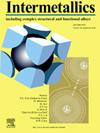热变形过程中蜂窝反应对β固化γ-TiAl基合金力学行为和微观结构演变的影响
IF 4.3
2区 材料科学
Q2 CHEMISTRY, PHYSICAL
引用次数: 0
摘要
本文章由计算机程序翻译,如有差异,请以英文原文为准。
The effect of cellular reaction on mechanical behavior and microstructure evolution of β-solidified γ-TiAl based alloy during hot deformation
In this work, the effect of cellular reaction on the mechanical behavior and evolution of the microstructure of the Ti-43.2Al-1.9V-1.1Nb-1.0Zr-0.2Gd-0.2B (at.%) alloy during uniaxial compression at Т = 1050 °C, έ = 10−3 s−1 and ɛ = 70 %. The lamellar (HT1) and metastable α2-grain (HT2) initial structures were produced by heat treatment and used as starting materials. Heating to the deformation temperature of the HT1 condition has not resulted in any noticeable changes in the microstructure, while HT2 microstructure transforms to (α2+γ) nanolamellar colonies alongside with development of a cellular reaction with the formation of coarse lamellar colonies. In the HT2 state, compared to HT1, the flow stresses are significantly reduced and the nature of the mechanical behavior changes. This behavior was associated with the localization of plastic flow in coarse lamellar colonies, and the development of recrystallization and spheroidization processes in them. By the final stage of deformation, the proportion of recrystallized/spheroidized structure increases in the HT2 state to 87 %, while in HT1 it is only 50 %. Mechanical behavior, structural evolution, and plastic deformation mechanisms are discussed.
求助全文
通过发布文献求助,成功后即可免费获取论文全文。
去求助
来源期刊

Intermetallics
工程技术-材料科学:综合
CiteScore
7.80
自引率
9.10%
发文量
291
审稿时长
37 days
期刊介绍:
This journal is a platform for publishing innovative research and overviews for advancing our understanding of the structure, property, and functionality of complex metallic alloys, including intermetallics, metallic glasses, and high entropy alloys.
The journal reports the science and engineering of metallic materials in the following aspects:
Theories and experiments which address the relationship between property and structure in all length scales.
Physical modeling and numerical simulations which provide a comprehensive understanding of experimental observations.
Stimulated methodologies to characterize the structure and chemistry of materials that correlate the properties.
Technological applications resulting from the understanding of property-structure relationship in materials.
Novel and cutting-edge results warranting rapid communication.
The journal also publishes special issues on selected topics and overviews by invitation only.
 求助内容:
求助内容: 应助结果提醒方式:
应助结果提醒方式:


